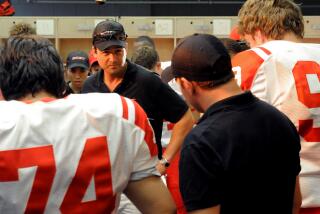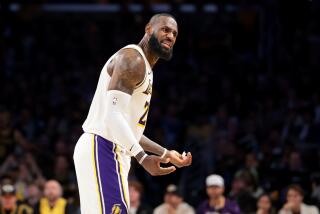REBUILDING BLOCKS
PHOENIX — I don’t think we’re in study hall anymore, Toto.
If Tyson Chandler ever forgets he’s not a high school All-American anymore, he has a lot of people to remind him, as in last week’s game here, when his Chicago Misera-Bulls came out of a timeout to find there was no seat on the bench for the veteran Greg Anthony.
So Anthony ordered Chandler to give up his and sit on the floor, which Chandler did, like a good rookie.
“Don’t talk to him like that!” a fan sitting courtside yelled at Anthony.
Chandler turned around and grinned.
“Don’t mess with our family!” Anthony yelled back.
If family they are, they aren’t Ozzie and Harriet, more like a band of refugees, huddled together for warmth in an unfeeling world.
The Bulls were then on their way to a defeat, dropping their road record to 1-20. In 31/2 seasons since Michael Jordan retired, Scottie Pippen was traded and Phil Jackson fled, they have won a total of 55 games while losing 205 and failing to rebuild anything.
Having traded Elton Brand to the Clippers for the Chandler’s skinny seven-foot body and potential, they’re back to square one, Chandler having only last week ascended to the starting lineup after spending the first three months of his NBA career on the bench, where they let him sit, next to fellow first-round pick out of high school Eddy Curry.
Meanwhile, as if to underline the Bulls’ misery, their icon, Jordan, returned with the Washington Wizards, who used to wallow in the depths, although not quite at the Bulls’ level, but now are playoff contenders.
Of course, Jordan was just in Chicago for his homecoming, an awkward affair in which the fans gave him a two-minute standing ovation, there was a controversy about who then ordered the house lights dimmed, both teams stunk out the gym before the Bulls--who else?--lost.
Their fans, who once seemed to live for little else, are melting away. In Years 1 and 2 of the rebuilding project, the Bulls still led the NBA in attendance; in Year 3 they were No. 2; now they’re 11th. Chicago is back to the way it was, a Bear town again, with the Cubs second and the Bulls as neglected as in their odoriferous early days, when they played next door to the stockyards.
On the positive side, the Bulls’ strategy just might lead somewhere ... eventually ... and in the meantime, they’re handling themselves like men.
Center Brad Miller later compared that Wizards game to “a 200-foot drop.” That, he said, was better than their next loss, at Indiana, which he likened to a mere “180-foot drop.”
Then there’s their resident Oscar the Grouch, Charles Oakley, brought back to Chicago, where he started his NBA career, for veteran leadership.
Laughs too, it turned out.
In Chicago, Oakley has become the most quoted American humorist since Will Rogers, with lines such as, “What do we have to be embarrassed about? We’re an 8-31 team.”
Oakley, who’ll be a free agent, also features ringing denunciations of the organization, such as: “They had the best players and the best coach and the best team in the world and they got rid of them while they were still winning. Why? They don’t really care about winning. They just care about making money. And don’t talk about this organization being any family and me keeping stuff within the family. Family left when they ran Phil Jackson and Michael Jordan out of here. Family left when they broke up the dynasty before it stopped winning. You make decisions like that, be man enough to pay the consequences. The way they’re doing things, the Bulls are 10 years away from being any playoff team.”
The organization tried having staffers sit in on interviews, but Oakley would wave them away. “The staffers,” noted the Chicago Tribune’s Sam Smith, “not the press.”
Having tuned out Coach Tim Floyd until he had little choice but to resign, the Bulls actually try these days for his successor, Bill Cartwright, although, lacking scorers, it’s still hard going.
No One Said It’d Be Easy, or Possible
“They had a certain kind of arrogance when you walked in, from the security people to the people in the restaurant turning their nose up at you when you went to the locker room....
“The [complimentary] tickets they gave you were way up in the nosebleeds. Everybody gives you a couple tickets down low or in the middle. Theirs were way up on top.
“But they’re down low now.”
--The Knicks’ Shandon Anderson on the Bulls
What goes around, comes around, however reluctantly.
It was a heady ride, but it’s over, and the rebuilding project owner Jerry Reinsdorf and General Manager Jerry Krause once talked about with such enthusiasm seems to stretch endlessly before them.
Krause, a defensive, thorny personality with a genius for calling down fire on his own position, takes the heat, but it was Reinsdorf who called the shots, primarily for economic reasons, hoping to bring in free agents such as Kevin Garnett before the leases on the United Center’s luxury suites came up for renewal.
And it was Reinsdorf who further failed to realize that by giving Krause free rein and keeping everyone else in his place, he was creating the perception of an organization so player-unfriendly, no one of note would deign to take $70 million of his money.
Two years into the rebuilding effort, having hoarded enough salary cap room for two big-ticket free agents, came the humbling summer of 2000, when they couldn’t get Tim Duncan or Grant Hill to visit; when Tracy McGrady came but left for Orlando as soon as the Magic made him an offer; when Eddie Jones agreed to terms, even dictating quotes for the news release, until the Charlotte Hornets worked out a last-minute deal and he opted for Miami, instead; when local papers reported Tim Thomas would sign, only to see him return to Milwaukee where he’s still a reserve; when aging Glen Rice agreed to terms, then, with staffers waiting at O’Hare to whisk him to the news conference, got another offer and flew to New York instead.
Nor would the summer of 2001 be a lot of fun.
With the No. 4 pickin the draft (the Bulls’ new specialty, compiling the worst record but failing to draw the top pick), Krause traded Brand for rights to the Clippers’ No. 2 pick, Chandler.
Now, with Brand looking better than anyone imagined he would with the Clippers, Krause is pilloried anew by critics asking why he didn’t keep Brand and draft Curry.
The answer is that Chandler was the one that experts such as Jerry West and Elgin Baylor thought had the best chance to explode to the upside. Had there been no trade, Baylor was set to happily keep Chandler.
However, Krause’s trade seemed to flip out Floyd, Krause’s protege, who had dutifully taken his lumps for three seasons to the tune of 45-169, making him the least successful coach in NBA history, who now longed to compete.
So, in Year 4, Bull fans were treated to the spectacle of Krause’s protege refusing to play Krause’s kids, Chandler and Curry, going (down) with veterans instead, opening with a 70-loss pace that would have been even worse than Floyd’s first three seasons.
Along the way, Floyd had blowups with Ron Artest, who was injured, for wearing sweats on the bench; with Oakley whenever he said something, which was almost daily; and with the press for asking why the kids weren’t playing and reporting strains in Floyd’s relationship with Krause, until the overmatched coach could stand it no more and quit.
His successor is the dignified Cartwright, a hard-working center in his time, known for his elbows but also, by people who knew him, for his intelligence and dedication.
These days the Bulls are more like a basketball team than a farce, at least competing nightly.
Meanwhile, Chandler and Curry continue to develop, but, unfortunately for the Bulls, only one day at a time.
Da Kids
“It’s the balloons and all those things they’re waving. They didn’t have that in high school.”
--Curry, on missing free throws
If all the ills of modern basketball were visited on one child, you’d have Chandler’s life story.
Identified as the Next Big Thing in puberty, he has been a figure of controversy since eighth grade, when “60 Minutes” did a feature about him, a smiling, fresh-faced 6-10, 14-year-old, sitting cross-legged on a basketball court, talking to correspondent Leslie Stahl.
Chandler remembers it as flattering. Actually, it was about the funding and corruption of youth programs by shoe companies. In Chandler’s case, it was Nike through its local representative, Pat Barrett.
Of course, this is how the system works, especially in Southern California, considered the Wild West of youth basketball. In the absence of any restraint, legislative or otherwise, on the grown-ups and the companies, the onus falls on teenagers, who are not only young but often from impoverished backgrounds, like Chandler.
In later years, the flak would get heavier as Chandler drove to Dominguez High his senior year in a Cadillac Escalade. Sports Illustrated did a story on him, but this time Tyson, by then 19 (and 7-01/2, 224), saw where the magazine was going and declined its interview request.
Now living in the Chicago suburbs in a leased house, with former Pepperdine player Tommy Lewis, an old Barrett guy, Chandler drives a brand new Escalade, which he bought.
Best of all, no one cares. He’s an actual professional now, working for money--$1.9 million this season--rather than gifts and gear.
Of course, now it’s no longer a game, but a job.
“The only thing I saw was the glamorous side of it,” he sighs, sprawled on a sofa in the Ritz Carlton Hotel, “just being able to play against the best players, the traveling--that’s all I saw. I didn’t really know how much you’ve got to put into it....
“Yeah, it’s been real tough. All through my high school career and, you know, going to a team that’s down in the dumps right now and losing a majority of our ballgames, that’s a tough thing to deal with.”
Amazingly, although he knew he’d turn pro--there was even talk he’d come out after his junior year--he says no one warned him about the down side, the fact he’d be brought along so slowly.
Now, when he calls his friends, Cedric Bozeman, who’s at UCLA, Josh Childress (Stanford) and Jamal Sampson (California), they tell him he has it made and he tells them how it really is.
“Sometimes they’re sarcastic about a situation, like, ‘What you got to worry about?’” Chandler says.
“They’re trying to get to where I’m at. Of course, playing college right now, they’re trying to go to the next level and so they’re asking questions and I tell them things that they need to do to prepare themselves, that, you know, nobody told me about.”
That’s a lot. High school and AAU coaches may or may not be able to prepare teens for college, but the NBA is another world.
NBA 7-footers have to play under the basket, or the utility of their height vanishes. Unfortunately, Chandler has arrived, without bulk or post moves, having been allowed to float all over the floor if he wanted to.
But it’s way early. Even superstar talents such as Garnett and Kobe Bryant needed years to settle in.
Cartwright is making the kids earn their minutes. Chandler (14.6 minutes, 51% shooting from the floor) has been moving up, but Curry (10.6 minutes, 41%) hasn’t. However, the coach says both are willing workers, who are on the floor at 9 for 10 o’clock practices, for extra work.
It might yet work. It’s just that, one way or another, it’ll be years before they know.
In the meantime, Chandler still insists, happily, this was “the greatest decision in my life, so far.”
Of course, Oakley has his own perspective.
“It’s a new generation,” he says. “It ain’t like it was when I first came in. You had to be on click, on tick, got to know the whole game to play. Now you don’t have to know. They draft you, they’re gonna play you ....
“They [young players] aren’t as smart as they used to be in olden days. They don’t know the game and they’re not getting taught the game.
“They got some athletic ability, but, like I said, back in the old days, athleticism didn’t get it. Now it gets it. Dunking, this and that, energy, it’s just a different ballgame.”
Ask anyone in Chicago, it’s way different.
More to Read
Go beyond the scoreboard
Get the latest on L.A.'s teams in the daily Sports Report newsletter.
You may occasionally receive promotional content from the Los Angeles Times.










